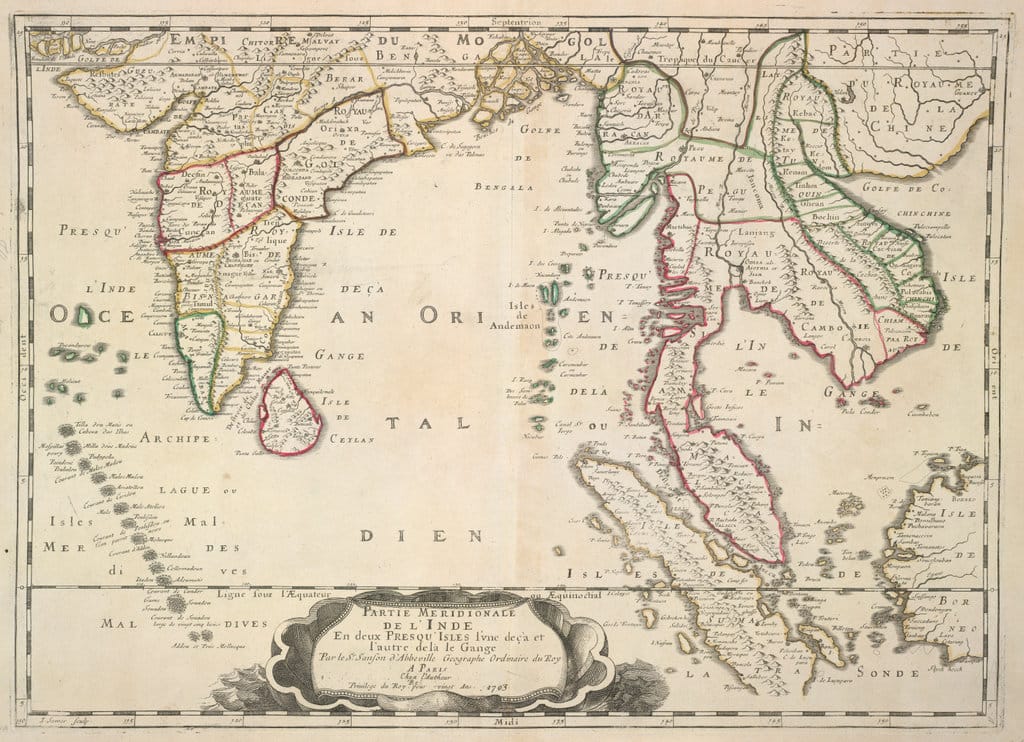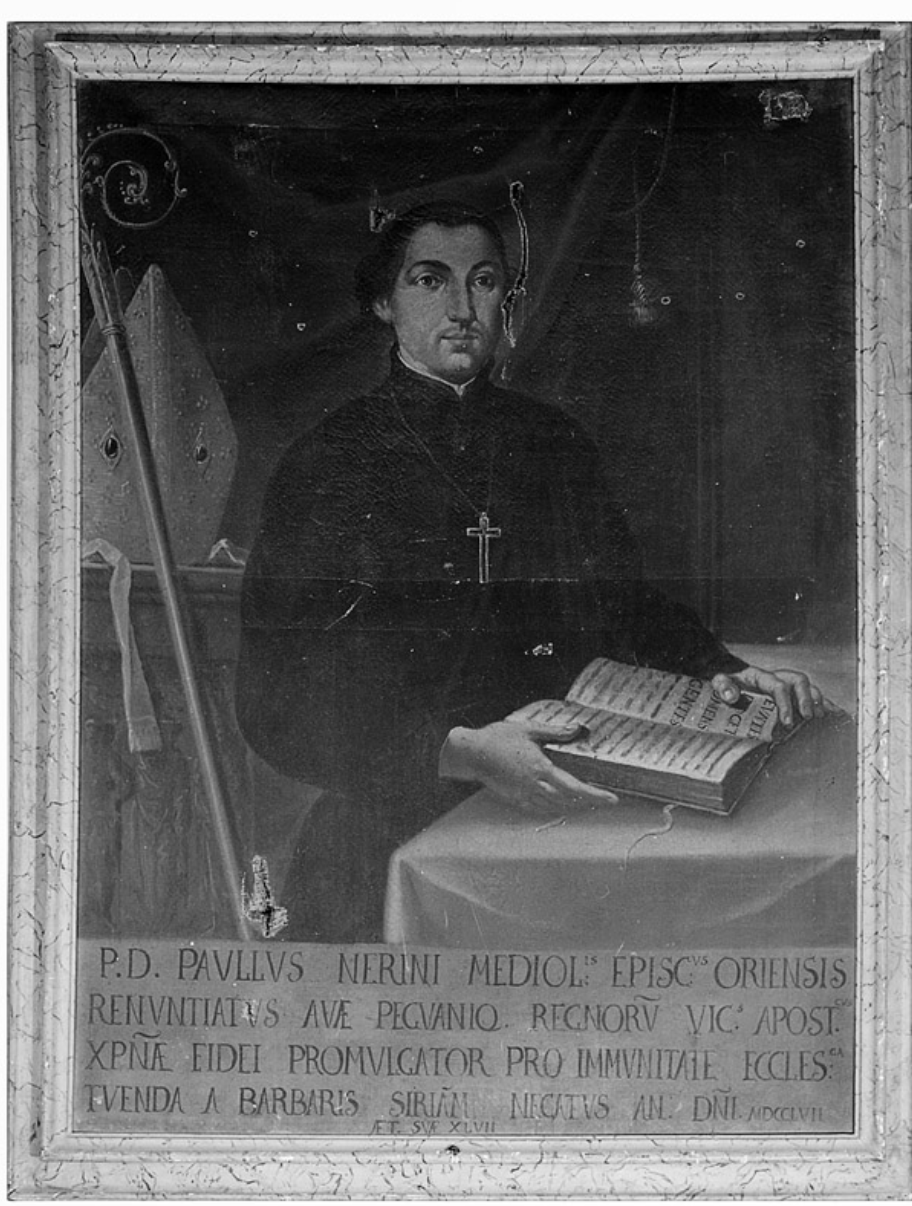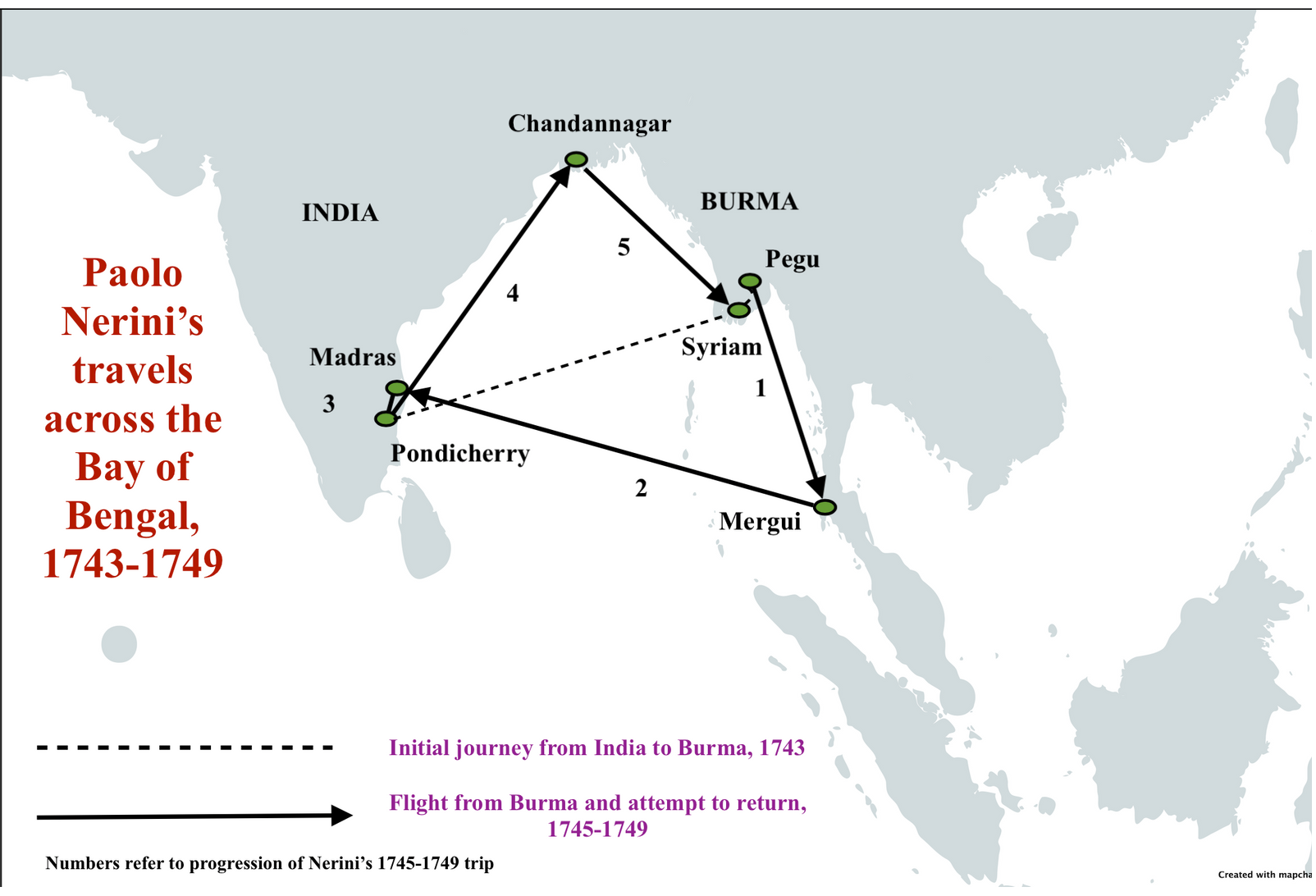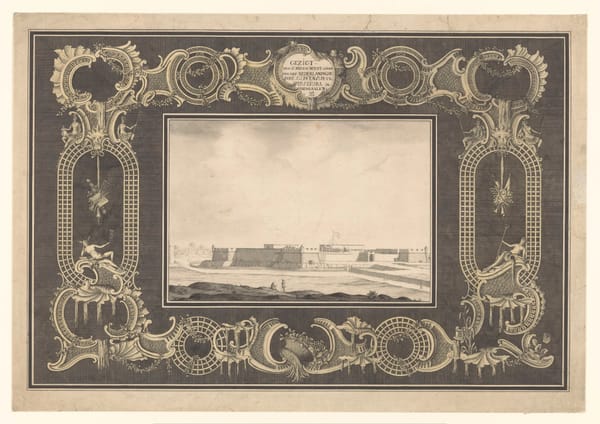Hitching a Ride: The transport woes of a Barnabite in the Bay of Bengal, 1745-1749

“Sufficiently have I already criss-crossed the Indian Ocean, passing from Pondicherry to Pegu, from Pegu to Mergui in the kingdom of Siam, from Mergui to the Coromandel coast, from that coast to Bengal, from Bengal to Syriam. These journeys, added to the first passage of Europe to India, form many thousands of leagues, enough to go around the whole world.”
Monsignor Nerini, in a letter to his Barnabite brothers, [from] Siriam, 15 March 1754
In January 1748 Paolo Nerini (figure 1), a priest from the Catholic order of the Barnabites, reported to his superiors in Italy that he was stranded in Chandannagar, a French bastion in Bengal. Nerini had been an unwilling resident of the town since January 1746 (Gallo, Storia, 226). He was eager to get out of dodge, for his intention was to make his way back to Pegu in Burma (present-day Myanmar) to re-establish the Barnabite mission in Pegu. The Barnabite presence had been snuffed out in 1745, when two of its priests were murdered along with a group of refugees recently expelled from the Habsburg factory in Bankibazar. These were the last remnants of the long-defunct Ostend Company, an entity with which the Barnabites had close relations from its inception in the late 1710s (for more on the order in Burma and the Ostend Company see Lovison, "La missione dei Chierici").
Under their leader François de Schonamille, the erstwhile chief of the Bankibazar factory, the refugees from Bengal had landed at Syriam in Burma and attempted to set up a trading community (Gallo, Storia, 130; For more on Schonamille, consult Dreijer, "The Afterlife"). The exiles immediately made contact with the tiny Barnabite community in the area. Though the exact circumstances are murky, Schonamille either attempted merely to winter in the area or to restore Pegu to its former Burmese ruler as part of a wider bid to create a de facto colony. Barnabite official histories maintain that the local Barnabites encouraged Schonamille to follow the course of peace, even though he preferred to engineer a coup d'état (Gallo, Storia, 130-132). After appearing at the Hanthawaddy/Mon court of Pegu, the king ordered the annihilation of the Austrian party, as well as a Barnabite missionary and the local archbishop, who had tried to act as intermediaries between the refugees and the sovereign (Gallo, Storia, 131).

After the massacre, Nerini fled southward from Syriam to Mergui (figure 2), hoping from there to return to Pegu, but his way was reportedly blocked by the density of the forests and the skirmishes in the Bay of Bengal between the English and French (Gallo, Storia, 144). The Barnabite then shuttled between Pondicherry, Madras, and Chandannagar (Gallo, Storia, 144-145), covering a total of eight thousand miles over the next four years (according to a nineteenth-century historian of the order, Luigi Gallo). From the moment he fled Burma, Nerini faced an uphill battle in reviving the Barnabite mission in Pegu. His greatest logistical hurdle was getting back from India to Burma, an undertaking that required him to hitch a ride on any one of the cosmopolitan band of ships that plied these waters. The priest was no stranger to the travails of sailing across the Bay of Bengal, for his initial trip to Burma was replete with setbacks. In 1743 he described in a letter how he had been forced to take refuge in Madras after boarding an Armenian ship in Pondicherry bound for Pegu (Gallo, Storia, 194). After twenty to twenty-five days of sailing, days in which the ship was pounded relentlessly by storms, they were informed by a “Moorish” ship that they were only one day’s journey from India (Gallo, Storia, 195). By this time, if one includes his outward journey from Europe, Nerini had been traveling towards Pegu for over eighteen months. Depressing though this episode was for the priest, the period 1745-149 would prove far more trying for him.

The obstacles were manifest from the moment Nerini arrived in India. In 1746 the Barnabite tried to set out from Madras, where he had journeyed after leaving Mergui (now in the southern stretches of Myanmar). Upon his arrival in Madras, Nerini had been impressed by the reception given to him by the British governor, who had come out to greet the party (Gallo, Storia, 206). Following a further delay of four months, Nerini set out on a ship for Pegu, but because it was outside the monsoon season, the vessel could not land at Pegu and was damaged when entering into a river. Once he disembarked at Madras, the city was surrounded by the French fleet, which occupied the city for a brief period (Gallo, Storia, 226). Nerini then sailed to French-controlled Pondicherry, but - as he himself remarked, “as if the war followed me everywhere” (quasicchè la guerra mi seguisse dappertutto) - an English squadron surrounded the city not long after he touched down, compelling him to remain in the enclave for eleven months. Thereafter, he traveled northwards by ship to French Chandannagar, where he lodged first with some Italian Capuchins (tasked with the proselytization of Tibet) and later with some French Jesuits (Gallo, Storia, 228, 238).
By January 1749, a full year after he had reported his imminent departure for Pegu to his Barnabite brothers, Nerini was still marooned in Chandannagar. In that month he wrote to the Reverend Father of the Barnabites that he encountered the same difficulties sailing out of Bengal's Ganges delta as he had on the Coromandel coast back in 1746, laying blame at the feet of those European vessels of war that seized ships and obstructed the commerce of Asian and European merchants alike (Gallo, Storia, 235). By the end of 1749, at long last, Nerini wrote to his Italian brethren from Syriam in Burma, having landed there in April of that year on a ship of unknown provenance.
As Nerini’s complex itinerary clarifies, the story of Catholic proselytization in early modern maritime Asia was tightly bound up with the infrastructure of the factories and the ships that connected them. Crucially, Nerini was not merely dependent upon Catholic Portuguese and French ships and settlements, but had to move regularly outside his own religious networks and those of Catholic imperial powers. If the Jesuits of the sixteenth and early seventeenth century had tended to rely on Portuguese shipping in Asia, they were compelled in the latter part of the 1600s to make use of Dutch and English vessels. From at least the middle point of the seventeenth century, China-bound Jesuits had begun using VOC ships to travel to Asia or for the dispatch of correspondence, the so-called via Batavica (Golvers, "The XVIIth-Century Jesuit Mission"). Supposedly, the price for their passage on ‘Protestant’ vessels was silence about religious matters (Friedrich, The Jesuits, 474).
When it came to intra-Asian maritime travel, by the mid-eighteenth century, Catholic clergymen like Nerini regularly made passage between ports in the Bay of Bengal on a variety of Armenian, European, and ‘Moorish’ ships. Needless to say, greater familiarity with the cosmopolitan makeup of passengers and crew on board these craft did not breed a broader tolerance for heterodox beliefs of European and Asian others. Nerini, in his last letter from Syriam before his period of exile, was scandalized by the “schismatic Armenians, the heretical English and Dutch,” a portion of whom, he wrote, “spend years without hearing Mass, others are old and have never been to Confession, and not a few who do not know the Our Father, nor the Creed, nor the sign of the Holy Cross, and consequently as a Christian they have nothing but the baptismal mark to disgrace him” (Gallo, Storia, 219). Schismatics and heretics these groups may have been in Nerini's calculation, but their shipping resources were instrumental to the project of Catholic missionaries in Asia.
Nerini’s second stay in Burma ended, as it did for his Barnabite colleagues in 1745, in martyrdom. He had, it seems made some strides converting locals, including a prominent Armenian merchant, to Catholicism. But in 1756, in a repeat of events of a little over a decade before, the Barnabite mission became swept up in yet another conflict between Mon and Burmese, a conflict which led seprately to the eradication of the French factory in Syriam and the English factory in Negrais around this time (Khazeni, The City and the Wilderness, 79). Nerini was among those killed in these contests, reportedly struck down in his church by a gang of soldiers while attempting to protect his flock (Gallo, Storia, 167-169).
Given its round-about quality, Nerini’s efforts to traverse the Bay of Bengal are instructive beyond what they says about the Barnabites in particular or Catholic proselytization in mid-eighteenth-century Asia more generally. For one, it underscores how the actors of a third European party (in this case, members of a minor Catholic religious order) navigated Anglo-French rivalries in India and Burma, a rivalry in which assertions of neutrality did little to immunize bystanders from the violence exacted by both sides. Second, as hinted at earlier, Nerini’s saga conveys how maritime connections among various parts of the Indian Ocean were often threadbare, held together by the connective tissue of the factory and the ship. While the ship frequently arrived at its destination only after numerous setbacks and interruptions, the factory was subjected to siege and expropriation by European and Asian combatants. The fact that it took four years for Nerini to complete his circular odyssey across the Bay of Bengal - interrupted, to be sure, by wars on sea and land - is a corrective to a tendency to assume contact across the Indian Ocean to have been a constant. In many cases, contact was seasonal and intermittent, and prone to pass away on account of a host of environmental and human factors.
Sources
Gijs Dreijer, "The Afterlife of the Ostend Company, 1727–1745," The Mariner's Mirror (2019), 105:3, 275-287.
Luigi Gallo, Storia del Cristianesimo nell'Impero Barmano, preceduta dale notizie del paese, Vol. 1 (Milano: Libreria Arcivescovile, 1863).
Noël Golvers, “The XVIIth-Century Jesuit Mission in China and Its 'Antwerp Connections’. I. The Moretus Family (1660-1700),” Marcus de Schepper and Francine de Nave ed., Studies over het drukkersgeslacht Moretus (Antwerp: 1996), 157-188.
Arash Khazeni, The City and the Wilderness: Indo-Persian Encounters in Southeast Asia (Oakland: University of California Press, 2020).
Filippo M. Lovison, "La missione dei Chierici Regolari di S. Paolo (Barnabiti) nei regni di Ava e Pegù (1722-1832)," in Barnabiti Studi. Rivista di ricerche storiche dei Chierici Regolari di S. Paolo (Barnabiti), 2000, n. 17, 1-393.





